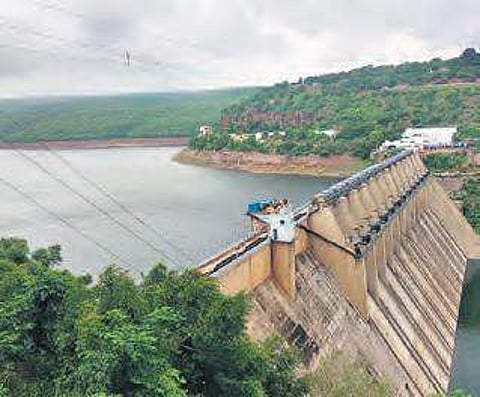

On Monday, Chief Minister YS Jagan Mohan Reddy announced the AP government’s decision to increase the drawing capacity of Pothireddypadu head regulator and Srisailam Right Main Canal (SRMC) to 80,000 cusecs from the present capacity of 44,000 cusecs.
Repercussions of this decision on Telangana projects in the Krishna basin is being debated seriously by intellectuals in Telangana.
Right from Helsinki Rules, 1966 to the present United Nations Water Courses Convention (UNWC), 1997, all emphasise that the areas in a river basin should get equitable and reasonable water share. Unfortunately, these internationally accepted principles of natural justice have been violated in the Krishna basin.
Telangana, which is well within the Krishna Basin, has been denied equitable share of water, not even sufficient to meet requirements of one crop, while a large quantum (about 70 per cent of their earmarked share out of dependable waters) is given to AP for two or three crops.It had been a strategy of the erstwhile State of Andhra Pradesh to construct projects and in the course of time, claim rights under the name of established utilisation.
Any innocent person, generally feels that “what’s wrong in it!” They might say, “since they have been utilising the water for many years, how can they be denied their existing utilisation.” But, the fact is that those persons would not be in a position to know that similar projects in Telangana region which are well within the Krishna Basin, were neither proposed nor started. Even if started, they were delayed perpetually on some pretext or the other.
At least 99.5 per cent of area of Telangana is under two river basins namely, Godavari and Krishna, and the aspirations of the people of Telangana are dependent on the utilisation of these waters. It is pertinent here to mention the observations of Indus Commission, 1942 that the equitable allocations once made cannot stay the same forever.
Krishna tribunals have also expressed that allocations can be reviewed under the changed circumstances. The Krishna Tribunal had allocated waters to three riparian States namely, Maharashtra, Karnataka and erstwhile Andhra Pradesh, in ‘enbloc’ (i.e, mass allocation) by totalling the demands of the projects. These allocations are not tied to any particular project and the States were allowed to utilise the water, wherever and in whatever manner they want, within the overall allocation of the States.
In the AP State Reorganisation Act, 2014, the Krishna Tribunal has been extended to make project-wise specific allocation among AP and Telangana. After bifurcation of the State, to facilitate sharing of water temporarily till the Tribunal gives the decision, on the initiation of Telangana Government and the Central Government, it had been agreed by both the States to share water on ad hoc ratio of 299:512 (811 tmc allocated by the KWDT-I as en bloc to the erstwhile AP).
As the then AP government had stressed more on the needs of coastal areas, the KWDT-I (1973 ) allowed Srisailam only as a hydro-electric project. To have a canal to serve the areas outside the basin areas from Srisailam reservoir to avoid objections from the other riparian states, the then government of Andhra Pradesh arrived at an inter-State agreement in 1976, and procured sanctions for Srisailam Right Branch Canal by planning Commission in 1981.
Though the SRMC was originally planned for 1,500 cusecs in the agreement, it was taken up in 1983 with an enhanced capacity of 11,150 cusecs including a head regulator (at Pothireddypadu) with the same capacity. Curiously, the canal was provided with three cross regulators at Banakacharla each having a capacity of 11,150 cusecs.
Later in 2006, stating the reduction in flood days to 30 days, the capacity of the Pothireddypadu and SRMC was enhanced to 44,000 cusecs. Presently, PRP head regulator has four old gates (three and one standby) and four new gates (nine plus one standby) and a power sluice, with a total discharge capacity of 1,77,000 cusecs. However, the capacity of the canal (SRMC) governs the discharge through the regulator, the canal can discharge only 44,000 cusecs.
Now, the discharge of the canal is proposed to be increased to 80,000 cusecs. In fact, the canal capacity could be enhanced to 85,560 cusecs by simply laying concrete lining. At the same time, the Telagnana side, which is left side of the Srisailam reservoir, Srisailam Left Bank Canal (SLBC) with 150 tmc ft utilisation, under gravity, which was proposed before the Tribunal in 1970, was reduced to 30 tmc ft in 1985 with 4,000 cusecs discharge and tied water allocations with Polavaram project.
The enhanced capacity of Pothireddypadu will seriously affect Telagnana projects like Kalwakurthy, Palamuru-Rangareddy, Dindi Lift schemes and SLBC Tunnel Scheme.
The Central agencies such as NWDA, CWC and KRMB should take initiative to protect the interests of the inhabitants of severely drought-prone and fluoride affected areas of Krishna Basin in Telangana.
The writer is officer on Special Duty to Chief Minister, Telangana.
At least 99.5 per cent of area of Telangana is under two river basins namely, Godavari and Krishna. Increasing the drawing capacity of Pothireddypadu Head Regulator to 80,000 cusecs from the present capacity of 44,000 cusecs will have repercussions on Telangana projects.